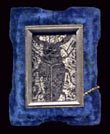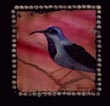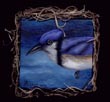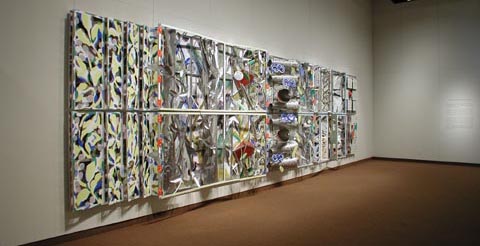|
|
|
|
|
|
|
|
|
|
|
|
|
|
|
|
|
|
|

|
Current Exhibitions Future Exhibitions Back to Exhibitions   Detail from Terra, 1988-2002, by Jacqueline Bishop  Detail from Terra, 1988-2002, by Jacqueline Bishop  Detail from Terra, 1988-2002, by Jacqueline Bishop  Installation shot from the exhibition. Silhouette, 2002, mixed media, 77 x 77 inches, by Jacqueline Bishop  Installation shot from the exhibition. Terra, 1988-2002, by Jacqueline Bishop |
Jacqueline Bishop: Terra and Gregory Zeorlin: Vines in our Forest June 6–September 15, 2002  Installation shot from the exhibition. Vines in Our Forest, 2001–2002, mixed media, 8 x 30 feet, by Gregory Zeorlin Jacqueline Bishop: Terra and Gregory Zeorlin: Vines in Our Forest opened Thursday, June 6 and continued through Sunday, September 15 at the Tyler Museum of Art. This exhibition showcased two large wall installations by New Orleans artist Jacqueline Bishop and Gregory Zeorlin of Tyler. Bishop's wall, entitled Terra, is an imaginary landscape of human conscience that serves as a memorial to the plight of the Amazonian rainforest and birds that find refuge in it. For the artist, birds are metaphors for man's soul and Amazonia is a mirror reflection of man's condition. As widespread messengers carrying information about the natural world, birds are often helpless witnesses to destruction of their own habitats. The installation measured 3 feet 10 inches x 39 feet 4 inches and consisted primarily of hundreds of small bird portraits painted with different color backgrounds to express the changing light of the day. The bird portraits are framed by debris: Mardi Gras beads, broken paint brushes, buttons, twigs, string, broken earrings, and children's toys. The debris—collected by the artist from the streets of Brazil, Bolivia, Venezuela, Peru, Boston, New York, and New Orleans—is an ironic reference to the cluttered habitats we share with birds and other natural creatures. As a poignant reminder of the artist's intentions, some of these birds have sadly become extinct over the seventeen years that Terra has been in existence as a work of art. The two accompanying pieces by Bishop included with her wall installation were Wooden Diaries and Silhouette (accompanied by the drawings in the Dark Organisms series). These works also explored similar themes of memory, the plight of nature, life and death, and beauty. Zeorlin's wall installation is titled Vines in Our Forest measuring 8 x 30 feet. Here the "forest" is the forest of poetic imagination that reaches back into childhood, into the unreflected realms of daily life, and the natural world that is intimately close. Made of three-dimensionally intertwined aluminum forms, the "vines" are stylized versions of poison ivy and Virginia creeper. Poison ivy has alluring qualities, says the artist, with its pearly berries and beautiful fall colors, yet "it causes us pain." Virginia creeper can often be found growing near poison ivy, and Zeorlin associates Virginia creeper with a "waving hand," seeing in its relentless climb to find the sun "something beautiful and challenging." This forest depicts for the artist "that which is simultaneously good, bad, ugly, beautiful, welcoming and offensive" in the sculptural form that is bold, colorful, and full of energy. The work of these two artists are singular examples of imaginary landscapes etched in their (and our) consciousness—one far off and the other near by—ut in either case the landscape depicted is intertwined in memory and language, for how else could such sophisticated imagery exist? Just as Gregory Zeorlin calls his work a "giant book" with "pages" referring to the separate frames that make up the piece, Jacqueline Bishop's Wooden Diaries are carved birds upon which she has written excerpts from her extensive diaries. Artist Statement by Jacqueline Bishop For the last twenty years I have focused on elements of the natural world in relation to humanity. For the last ten years I have left the studio and traveled through the disappearing forests of Central America and South America, particularly the Brazilian Amazon. The wall installation Terra began in 1985 and is a wall memorial comprised of hundreds of small painted bird portraits, some of which are endangered, abundant and extinct. Birds are universal signifiers of the landscape because they are rooted in regions, yet are widespread in their migratory scope. This weaving of the micro and macro is reflected in the installation itself, which is methodically pieced together, in a nest-like manner with bird portraits hung according to tone, from light to dark between dawn and dusk. Terra is about landscape painting and the flight of imagination, it is human conscience—light and dark and the changing landscape of life to death. It is about the human need for intimacy with nature. Wooden Diaries are considered books made from wooden birds carved by the Tikuna Indians in Brazilian Amazonia. They are covered with text, excerpts from my journals describing ten years of travels through the forests in the Amazon. I am interested in memory, the feminine connection to the natural world, the politicizing of nature, beauty, terror, life and death including murder and extinction. The Brazilian newsprint/collage drawings titled Dark Organisms are covered by a black veil of 182 birds hanging upside down titled Silhouette. The veil represents a "silhouette" of unidentifiable bird shapes that refer to the beauty and mystery of hidden places in the world and within us. Artist's Statement by Gregory Zeorlin The art titled Vines In Our Forest exists at several levels. It is a celebratory piece, full of color and energy. It is a visual interpretation of a poem. It is a colossal book that I think of as an illuminated manuscript. I experience a sense of wonder when I look at an ancient manuscript. A similar feeling occurs when I think about the stages we go through to become literate. It is a pleasure to help my children improve their abilities to read, write and communicate. Watching my children as they looked at marks and lines while learning to read influenced the way I now look at art. In those seemingly abstract marks there is order. My visual art is often an interpretation of a poem I have written. The poems are generally a response to something I have experienced or observed. Following the poem, a series of sketches are developed that lead to my three-dimensional object. This transition, from a poem as concept, to a type of physical poem (as sculpture) changed the way I look at words. Words and visual art both have rhythm, mass, color and energy. Vines In Our Forest is made of nine rows that are like verses in a poem. It is composed from hundreds of wooden and metal parts that could be thought of as individual words. When these parts are linked together a physical poem is created that reflects thoughts and energy. |